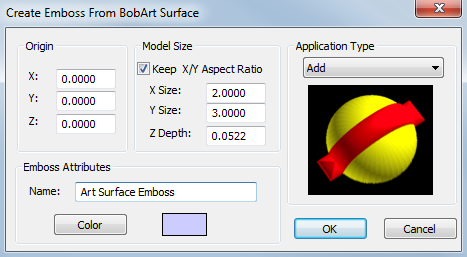Emboss from BobArt Surface (.bbas) File
Introduction
The Emboss from BobART Surface (.bbas) File feature is used to import a surface file previously created in BobART and use that surface for an embossed model.
Navigation
To create an Emboss From BobArt Surface feature:
- In the
 BobART
tab, right-click
BobART
tab, right-click  Emboss Model, and click Emboss from BobArt Surface (.bbas) File.
Emboss Model, and click Emboss from BobArt Surface (.bbas) File.
- In the Open dialog box, locate and select the surface file, and click Open.
The Create Emboss From BobART Surface dialog box displays.
The Dialog Box Parameters
![]() View the
Create Emboss From BobART Surface dialog box
View the
Create Emboss From BobART Surface dialog box
Origin
The Origin group sets
the emboss model location using the XYZ
coordinate
Model Size
- Keep X/Y Aspect Ratio
 Select the check box to lock
the aspect ratio of the imported file. Making a change in the X Size automatically
calculates the Y Size and vice versa.
Select the check box to lock
the aspect ratio of the imported file. Making a change in the X Size automatically
calculates the Y Size and vice versa.
 Clear the check box toadjust the size of the imported file
using the X- and Y-Size boxes independently.
Clear the check box toadjust the size of the imported file
using the X- and Y-Size boxes independently.
- Size X - sets the imported model length along the X-axis.
- Size Y - sets the imported model length along the Y-axis.
- Z Depth - sets the thickness of the imported model along the Z-axis direction.
Application Type
-
Application Type - indicates what kind of embossing is performed: Add, Subtract, Merge High, or Merge Low. For more information, view the Application Types help topic.
Emboss Attributes
-
Name - indicates the feature name that displays in the BobART tree. By default, it is automatically named by the feature type and number. Note that you cannot use the hyphen (-) character with spaces around it, as this is reserved for the automatic naming and will be removed. You can however use it without spaces, for example, Emboss-Body).
-
Color - opens the Color dialog box. Select the desired color for the feature, and click OK.
OK - accepts any changes and closes the dialog box. (The first time you click OK, the feature is created and added to the BobART tree.)
Cancel - cancels the creation of the feature (the first time that the dialog box displays). When editing the feature, this cancels any changes and closes the dialog box.
After defining the parameters, you use the Emboss Feature in the BobART Tree to finish creating, or edit, the feature.
The Emboss Feature in the BobART Tree
When you finish defining the feature parameters and click OK, the feature is added to the BobART tree. You right-click each feature item to access a shortcut menu.
The Feature Shortcut Menus
![]() Art Surface Emboss
Art Surface Emboss
Right-click this item to access the following commands.
-
Edit - opens the Feature dialog box for you to modify the feature parameters.
-
Delete - removes the feature from the tree. Regenerate to view the change in the model.
-
Suppress/Unsuppress - is used to remove the feature from the model or to restore a suppressed feature. To update the model, Regenerate.
- Save As Component/STL - is used to save the feature as a component or .stl file. This saves the individual feature and not the entire model. The STL Save Option dialog box displays for you to set the tolerance. Next, the Save As dialog box displays for you to select a location, name the file, and save it. The component can be used to create an Emboss from Component feature.
![]() Art Surface
Art Surface
Right-click this item to access the following command.
-
Re/LoadArt Surface - displays the Open dialog box for you to locate and select a BobART surface file (.bbas file). The art surface is applied to the model when you regenerate. You can use this option to replace the current surface file.
Generating the Model
After all necessary selections are made, you must regenerate to create the model.
To Regenerate the Model:
- Right-click
 Emboss Model, and click Regenerate.
Emboss Model, and click Regenerate.
Note: Every time a change is made to an Emboss feature, you must Regenerate to update the model.
